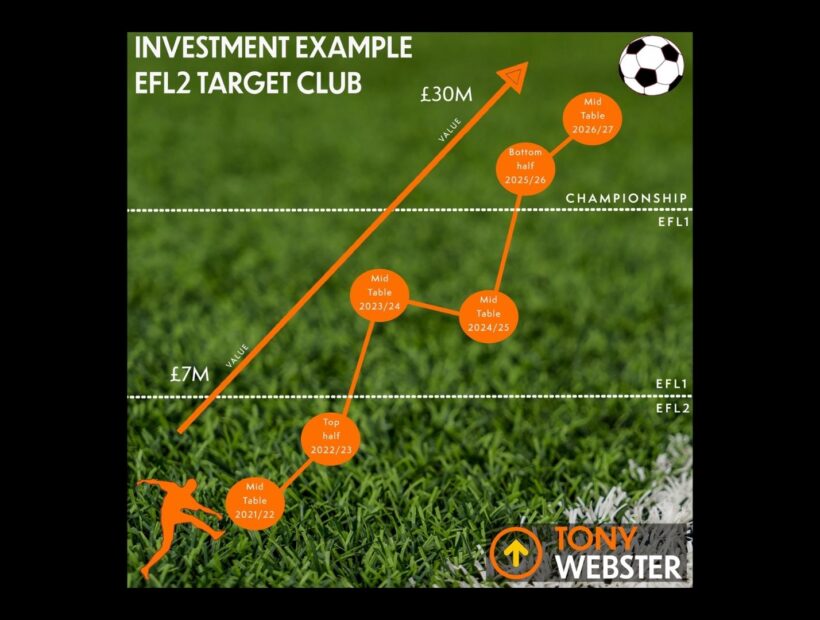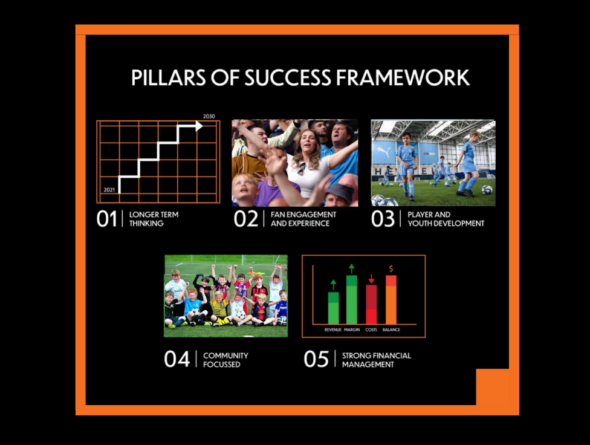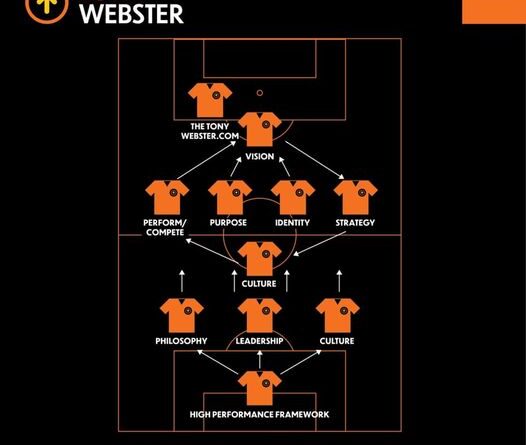Football is big business, but why do nearly all clubs make a loss? Many owners take a view they must make a loss to get to the top, ie the Premier League, accepting they have to invest huge sums to achieve that goal. Paying for the perceived best manager, subsequently sacking him and repeating the process with another manager, paying over the odds for players and agreeing to high wages. Then of course, emotion and ego come into play and all sensible decision making seems to get lost and the financial losses grow!! English football is littered with examples of this.
However, there is a way to make significant investment returns by applying basic business principles and the right strategy. After all, football clubs are businesses, with the majority being classed as small businesses. In this post, I will outline the methodology and approach needed to turn a £7m investment into £35m over 5 years.
BACKGROUND
Football is the No 1 game in the world and the Premier League is the No 1 league in the world. The popularity and power of football continues to grow globally and bring communities closer together. This is matched by increased revenues and sponsorship, with no sign of this changing as a new era of watching football is just around the corner.
A whole new fan experience will be born over the next few years, with streaming and digitalisation and new entrants into the arena such as Netflix and Amazon driving revenues upwards.
Additionally, 5G is set to revloutionise media rights with digital and technology being central to operations and stadium connectivity.
Internationally, USA is seeing unprecedented interest in MLS, USL, school’s soccer, college soccer and English football. China continues to invest internally in its football and recognises the benefits to its people and communities. India is the next big nation to enter the global scene.
Football is only going to get bigger and more lucrative.
LEADERSHIP
It starts at the very top and authentic leadership is the key function in leading the people, process and budget, with the whole team bought into the vision and honouring the trademark behaviours. Show humility, work hard, put the whole team first.
Behaviours – driven by our core values, builds and creates the high-performance culture
- Pride – in our heritage, colleagues and supporters
- Passion – we will succeed and we want to share it
- Professionalism – highest standards always – no excuses
- Perseverance – positive in adversity and steadfast in our vision
Successful Drivers
- Innovation is our competitive advantage. Agile, but considered in decision making, driven by purpose and energy
- Technology and digital enhance the high performance
- People development across the whole organisation, creating opportunities and capitalising on their talent through an integrated, open approach
Dream, Believe and Achieve
PHILOSOPHY
Central to all aspects of the organisation is the philosophy and start with a back-to-basics approach, starting with the heart of the club.
What does the club stand for? What does it mean to the fans? What is it’s history? What is its DNA, it’s purpose?
Once these factors are established, build from the ground up, through a clearly defined Purpose, Identity and Culture.
- With a clear Vision, build the club/business, the whole organisation first, rather than the ‘on pitch’ team. Make the club/business a success and consequential success on the field will naturally follow. Have a fully joined up approach across the whole organisation. Brighton, Portsmouth, Southampton and Norwich are good examples.
- The whole organisation should have positivity about it, with a belief and stronger together attitude. Everyone involved should understand what the club stands for, what we are trying to achieve and be committed to contributing towards it. Anyone that doesn’t share in this belief should be removed.
- All stakeholders should be treated as partners and fully understand the journey we are on. Collaborating and all pulling together, working together and stronger together. These include fans, the wider community, local schools, sponsors, corporate partners, players, staff and local government.
- Consistency, discipline, perseverance and patience are key across the whole organisation.
- With the right leadership, vision and strategy, the club will become a successful, financially sustainable and profitable business and football club. A club placed at the heart of the city, a club for the people and one the city and its people would be proud of.
- One Club, One Team, One Family. Stronger Together.
OPERATING MODEL
Key pillars for success:
- Mid to longer term plan, 5-10 years.
- Headline focus on value enhancement of the assets, ie – the players, through youth and player development. This is the number one priority, from which consequential success will follow across the organisation, both on and off the pitch.
- Proactive partnership and engagement with all stakeholders –
- Fans – engagement and experience
- Corporate/commercial partnerships
- Community focus – social conscience
- Local Government & Education
- International
- Embrace technology and digitalisation in all areas
- Maximise all revenue streams, cashless, contactless
- Leverage data, consumer data, basket data & behavioural data
- Excellent financial control and budgeting
- Recruit the best possible people within budget, based on character, personality, attitude and alignment with the club’s philosophy
- Whole organisation first approach, rather than a typical first team and silo mentality
Focusing on developing players, improving the team will mean:
- Better players
- Improved first team success
- Better results and more wins on Saturday
- Enhanced squad value
- Positive impact on all other revenues
- This value enhancement and subsequent realisation through player trading, offers a significant and sustainable additional revenue each season
- Consequential success on the pitch significantly enhances the enterprise value
- With reinvestment and succession planning in place, creates the financially sustainable operation
- Ajax are the world’s best example, with Norwich and Brentford operating similarly in England
Player and youth development is fundamental in a growth and self-sufficiency model:
- Player recruitment based on analytics and best fit for club
- Full use of data analytics, statistics, technology and data science in recruitment
- Focus on youth, but not exclusively
- Academy, with teams U9s to U23s
- Individual players development pathways to competing & the first team
- A Head Coach and the best possible coaches who develop and improve players
- Tight player contract budgetary controls
- A player value enhancement strategy at all levels
- A playing and coaching philosophy consistent throughout, from youth to first team
- Player succession planning in place for all positions
- Player trading could add £10m – £50m revenue per season
- Significant potential future value within current squad
Football clubs are all businesses and have two distinct departments, a football and non-football departments. Each should have a head and report into the board.
The Football Department:
- A “Club” philosophy and infrastructure, not dependant on any one individual
- A mix of youth & experience across all departments
- Club wide unified playing and coaching philosophy & style; high fitness, hardworking, high energy attacking football
- Data analytics & player personality/character are key factors in player recruitment
- Focus on “right fit” for the club & team, coachable, eager to learn and value enhancement potential
- Individual player development plans and pathways to first team, giving young players a chance
- One training location for all teams and age groups
- Collaborative approach
Non-Football Department – commercial/operations
- Drive ALL revenue streams
- Short term impact, long term benefits
- Innovation and creative thinking, ‘out of the box’
- Sponsorship partners, local, National & International
- Value beyond name exposure for partners
- Data & technology key across all departments
- Fan engagement & experience
- Data capture, with a single sign in CRM covering all fan touch points with the club
- Grow ALL social media channels
- Wider community engagement, social conscience
- Use of stadium on non-match days
- Low-cost benefits; outsourcing
- Sustainability, renewables, green energy
- Collaborative approach
FIVE YEAR PLAN
Guiding principles in applying this model and achieving financial self-sufficiency within 2 years are:
- Compassionate ruthlessness
- Demand our people’s best/quality
- Support and challenge our development – Challenge Culture – always moving forwards/ improving
- Have the best staff we can, all aligned to our aims and beliefs. Clear development and pathways for all
- Communicate and over communicate our messages to all, with transparency
Year 1
- Define the DNA of the club and establish the foundations for sustainable success, get the basics right.
- Short term impact methods & long-term foundational benefits. Promotion?
- Define and communicate our true IDENTITY and apply it in all areas.
- Define and drive all revenue streams as profit centres.
Years 2 & 3
- Building and starting to deliver success. Promotion?
- Making the City proud of their club.
Years 4 & 5
- Maturing the model and closing in on our goal.
TARGET CLUB
The best value investments lie in the lower leagues, EFL1 & 2, and National League where a typical investment could range from £1m to £25m depending on the club.
The example I have used to demonstrate the potential return is an EFL 2 club, (one club city, good stadium and fan base) with an acquisition cost of up to £5m and working capital requirement of £2m, a total investment of £7m. Five year project to develop the club along these lines and achieve Championship status, with an enterprise value of circa £35m.
And there are EFL2 opportunities at a lower total investment of £3m – £4m which equally will return an enterprise value of circa £25m+ after 5 years.
At a higher level total investment into a Championship club would be around £30m, but the value in 5 years would be over £120m with Premier League status.
At the lower end, a £1m investment in a National League club would return a club value of around £8-10m after 5 years, in EFL1.
If you would like to know more details and learn more about this opportunity, get in touch.



